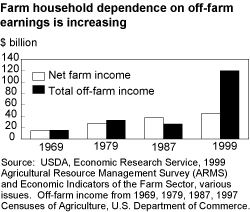The Economic Well-Being of Farm Households
- by Ashok K. Mishra
- 2/3/2003
Even as farming has changed markedly over the past century, so, too, have farm households changed—both in the way they farm and in the extent to which they participate in and identify with nonfarm activities, such as off-farm work and investment opportunities. Conventional wisdom has been slow to recognize this evolution.
Traditional assessments of the economic well-being of the farming population focused on farm income. Earnings from farming, however, are low for most farming households, and farm households have increasingly turned to nonfarm-related sources of income. A more accurate assessment of the well-being of those farming today would incorporate farm households' income from farm and off-farm sources. Wealth—as reflected by farm and nonfarm assets—and its role in shaping farm household consumption also need to be considered in any assessment of household well-being.
Most farm households participate in nonfarm activities and earn a major portion of their income from off-farm employment. (Actual income levels vary with household characteristics, including age, education, and family size.) Off-farm employment raises and stabilizes farm household income. In fact, when both farm and off-farm activities are considered, the average farm household has higher income, wealth, and consumption levels than the average U.S. household. Nonetheless, about 6 percent of farm households remain disadvantaged, having lower average income and wealth than the average U.S. household.
This article is drawn from:
- Farm Sector Income & Finances. (n.d.). U.S. Department of Agriculture, Economic Research Service.


